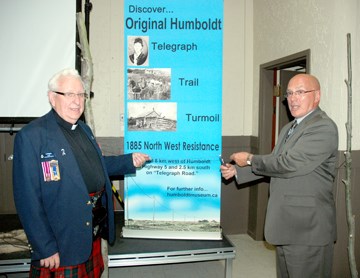The Original Humboldt Site may have been drowning in water, but that didn't stop the Humboldt and District Museum and Gallery from having a grand opening of the site.
On June 18, a Commemoration of Original Humboldt and the 1885 North West Resistance was held at the Bella Vista Inn.
A short program was held before the Original Humboldt Committee unveiled the site storyboards.
Storyboards were available for patrons to view, as the Original Humboldt site is water-logged.
"Since we couldn't take you to the site... we brought the site to you," said Rev. Alvin Hingley, Master of Ceremonies.
The storyboards explained a lot of the history of the Original Humboldt Site.
Attendees of the event were able to read the history of the Original Humboldt site, including George and Catherine Weldon, the telegraph station, Humboldt's role in the 1885 North West Rebellion, Chief Whitecap and the Carlton Trail.
At the program, they showed a video about the site, had actors portraying major people who affected Original Humboldt and speeches were given by honoured guests.
The five guest speakers were Dr. Gordon Barnhart, Lieutenant-Governor of Saskatchewan; Brad Trost, MP of Saskatoon-Humboldt; Delbert Kirsch, MLA of Batoche; Malcolm Eaton, Mayor of Humboldt; and Allan Duddridge, Saskatchewan Representative of the National Historic Sites and Monuments Board of Canada.
All five speakers felt privileged to be included in the celebration of Original Humboldt.
"On behalf of our council and all of the citizens of Humboldt and our district, I am very honoured to welcome everyone," said Eaton during his speech.
Barnhart, being a historian himself, was quite excited about the history of Original Humboldt.
He said after teaching history in both high school and university, he noticed many people claim history is boring, that it is just a lot of memorization of names and dates.
"But then you weren't really studying the true history," said Barnhart.
He feels Humboldt has a rich and important history, which was made evident after the video presentation.
"After this presentation I don't think anyone will think history is boring," said Barnhart.
Barnhart isn't the only one who felt history is not just about dates and names.
"We are here today to celebrate people, because, ultimately, that's what... history is all about. It's about people," said Trost.
All of the guests felt the history of Original Humboldt is very important to the community.
"What an important role our community has played in (the) development of Saskatchewan and Canada," said Kirsch.
"I'll bet that the majority of people in Saskatchewan don't know that in 1885, Humboldt played a major role in the North West Resistance. It was the Humboldt telegraph station, the first known building in the area, which allowed Dominion soldiers to remain in contact with Ottawa during the events."
The speakers expressed their thanks to people of the community for being interested in preserving Humboldt's history for future generations.
"Through locals it is preserved," said Duddridge about Humboldt's history.
Janet Hooke, the great-granddaughter of George and Catherine Weldon, also came to the event with her father, John Glockler.
Glockler and Hooke made some artifact donations to the museum before the program at the Bella Vista.
Hooke recently found, in her possession, a Bible that belonged to George Weldon. When she decided to get in touch with Jennifer Hoesgen, to donate the Bible, her father also mentioned he had some weapons that could be donated as well.
She was happy to be included in the celebration of Original Humboldt.
"I'm thrilled because it's part of my family heritage it's almost like an honour for me because they did a lot of hard work and for me I can keep that memory alive," said Hooke.
"It's really cool to dig into (George Weldon's) diary and then I can come here and actually see stuff too."
Hoesgen, Hooke and Glockler all believe the focus on children is a big part of preserving history.
"That's the big focus for us, kids," said Hoesgen about the museum programs and exhibits.
Hooke is an educational associate in St. Albert, Alberta. She has become an important part of the Grade 7 curriculum when they are learning about the North West Rebellion.
She said George Weldon's diary really helps her keep the children interested in history, because instead of naming days and facts, it explains what life was really like in those days.
"George's diary really helps because I get them thinking about stuff like, 'What do you think dogs ate back then because you didn't just go buy dog food?' That kind of stuff," said Hooke.
Hoesgen feels the same way as both Hooke and Barnhart.
"History is normally not written about the everyday life. It is normally written by the victor and it's about the battle, but it's that everyday life stuff that is so key," said Hoesgen.
"That's the point we try to make to kids the decisions you make about your community now are going to affect people (in the future)."
The only downside to the day, was the fact the actual site was too water-logged to visit.
The site has been excavated by Western Heritage Services. On the site they found many artifacts and found what they assume to be where the telegraph station once stood.
The guest speakers look forward to coming back to Humboldt when the ground is dry and they are able to visit the Original Humboldt site, located east of the city.
"We'll look forward to a visit back here again when the site is finished," said Barnhart.




